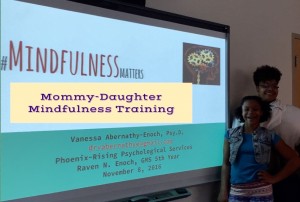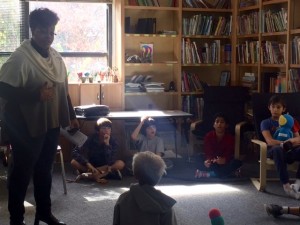In Upper Elementary science classes this trimester, our fourth and fifth level students have completed an in-depth unit on the human brain. They began by studying the different parts of the brain and their specific functions, and then they applied their new knowledge to learn how to strengthen their own brains. These 10 and 11 year olds took their studies one step further and delved into what current brain research teaches us about how we can maximize our own learning.
Students explored the seminal research of Stanford University professor, Dr. Carol Dweck, who coined the term "growth mindset." Dweck's research reveals that student achievement is directly related to a person's beliefs and attitudes about the value of hard work. Our Upper Elementary students learned about the attitudes that comprise a growth mindset and discussed how their own beliefs and attitudes affect their ability to learn.
 As a culminating activity, Upper Elementary hosted a special workshop on the practice of mindfulness as a tool to optimize brain function and reduce stress. The workshop was developed and presented by classmate Raven Enoch and her mother, Dr. Vanessa Abernathy-Enoch. This mother-daughter team shared a multi-media presentation on how the brain and body react to stress and the common sources of stress. They also led the students and faculty in basic mindfulness exercises they can use at home and at school.
As a culminating activity, Upper Elementary hosted a special workshop on the practice of mindfulness as a tool to optimize brain function and reduce stress. The workshop was developed and presented by classmate Raven Enoch and her mother, Dr. Vanessa Abernathy-Enoch. This mother-daughter team shared a multi-media presentation on how the brain and body react to stress and the common sources of stress. They also led the students and faculty in basic mindfulness exercises they can use at home and at school.
To learn more about how to promote mindfulness for yourself and your child, check out this booklist.
To recap their presentation and to demonstrate the importance of parent-child conversations about healthy living, we invited Raven (fifth level student) to interview her mom on the practice and health benefits of mindfulness. See the interview below.
Raven: Mom, what is Mindfulness?
Vanessa: In our workshop, #MindfulnessMatters, we talked about mindfulness as a mental state of awareness and the practices that promote such awareness: a moment-by-moment awareness of our own experience (e.g., thoughts, feelings, bodily sensations and surrounding environment) without judgement.
Raven: How does Mindfulness help with stress?
 Vanessa: Well, stress is a normal part of life and a necessary part of growing, even in childhood. Stress is simply our AUTOMATIC physical and emotional reaction to life's demands or challenges. Healthy amounts of stress can motivate us to take action. Chronic stress can lead to distress and eventually different types of problems and even illness (e.g., physical, interpersonal and mental). When life's demands exceed our ability to cope with those demands, it can be taxing to our body and mind. Mindfulness practices help to target our automatic and involuntary stress response to prevent or reduce the negative impact of stress and increase coping. Some of our automatic responses to stress include trouble concentrating, inability to relax, muscle tension, and increased heart rate.
Vanessa: Well, stress is a normal part of life and a necessary part of growing, even in childhood. Stress is simply our AUTOMATIC physical and emotional reaction to life's demands or challenges. Healthy amounts of stress can motivate us to take action. Chronic stress can lead to distress and eventually different types of problems and even illness (e.g., physical, interpersonal and mental). When life's demands exceed our ability to cope with those demands, it can be taxing to our body and mind. Mindfulness practices help to target our automatic and involuntary stress response to prevent or reduce the negative impact of stress and increase coping. Some of our automatic responses to stress include trouble concentrating, inability to relax, muscle tension, and increased heart rate.
Raven: Why is it important for kids my age to learn about Mindfulness?
Vanessa: Mindfulness and the practices that promote it can help students improve their abilities in calming their own bodies and minds. The benefits include sustaining attention, improving focus, ignoring distractions, regulating mood and emotions, improving sleep, and increasing readiness to learn. There are many, many benefits that lead to increased thriving and resiliency.
Raven: What are some exercises people can do to help with Mindfulness?
Vanessa: In our workshop we taught students a Deep Breathing exercise (slowly in through the nose and slowly out through the mouth), the 5-4-3-2-1 Relaxation Technique where you focus on your environment using 3 of your 5 senses, and an exercise in Mindful Eating.
[We were also proud to point out that Greensboro Montessori School offers students several opportunities in the course of the day to practice and promote Mindfulness, including exercise, journaling, leisure reading, listening to music, creating art and structured-free time (plus yoga in the primary program)].
Raven: How has practicing Mindfulness helped you personally?
Vanessa: Using Mindfulness practices helps me personally in many ways, including improving my memory, decreasing muscle tension, remaining calm in times of crisis and increasing assertive communication that has improved my relationships, especially with my friends and family. Most of all, it is helping me to do what I hope it will help you and your classmates do: to relate to others and myself with more warmth, acceptance and sensitivity.
What do the oldest fabric in the world and a vintage typewriter have in common with my dentist? And what do they have to do with art? Well, I encountered each of them in the course of one week, and the intersection of these seemingly disparate things gave me an “a-ha” moment about the symbiotic relationship between creating with technology and hands-on art making in our School’s art studio.
As a mixed-media artist, I am naturally drawn to tactile, malleable, hands-on materials and adore using these materials in my lessons. If you walk into Greensboro Montessori School’s art studio, you will see a variety of rich textures, fibers, paints, clay, found objects and nature. You will also find a technology wall where one of the School’s 3D printers, a computers and iPads live. These two worlds co-exist harmoniously in our art studio and with each new day I am learning and teaching how technology and art are interwoven and applied in the world beyond the studio.
For instance, many Greensboro Montessori School faculty recently participated in an excellent coding workshop from Code.org. During this workshop I learned how coding is fun and creative and identified a great way to apply this technology in my classroom. Once armed with coding knowledge, students can practice their skills by writing an algorithm resulting in a specific design being drawn on their computer. They can bring this code to their art lesson and exchange it with another student. From there, students run each other’s algorithm to see if it produces what the creator originally intended.
Another project where technology and art intersect is stop motion animation. Students use a stop motion app on our classroom iPads to tell stories, but they also use physical objects make stop-motion animation the good old-fashioned way (by moving an object in small increments, taking photos of the object after each movement, and viewing multiple photos per second in a continuous sequence to create the illusion of motion). One of the most famous stop-motion animation films is the 1964 television special, Rudolph the Red-Nosed Reindeer. In our classroom, students manipulate KEVA planks, not wireframe figurines, to make their movies. The excitement has been great, and upper elementary students often rush back to class to ask Cathy Moses to come see their work!
Middle school students have been very helpful in teaching upper elementary students about the School’s 3D printer and 3D drawing program, SketchUp, which brings me back to my “a-ha” moment about the connection between art and technology. Within the course of one week at school I led a felting project demonstrating how to create with the oldest fabric in the world and guided lower elementary students in a freedom of speech exercise where they used a vintage typewriter to create art with their own words. I was reminded how each of these discoveries represented a technological shift at the time of their invention. At the end of the week, I went to the dentist and experienced a modern technology and art revolution in the making.
As crazy as it sounds, and as personal a story it is, my time at the dentist was real-world affirmation of the integration of art and technology. I was scheduled to get a crown and had anticipated my visit being the first of two required to complete the procedure, but then I was introduced to CAD/CAM (computer-aided design and computer-aided manufacturing) dentistry. While I was in the office, my dentist used technology to capture a 3D rendering of my tooth (CAD) and reproduce it onsite with a grinding and milling machine (CAM). While the grinding process used in my dentist’s office is different from the fabrication method used in 3D printing, the use of technology to produce sculpture in both cases highlights the inspirational interplay between technology and art. (And to top it all off, my ceramic crown was fired and glazed onsite, just like our students’ pottery is fired and glazed in our kiln!)
As we continue to create with our hands in collaborative and productive ways in Greensboro Montessori School's art studio, we will continue to grow the use of technology as well, because technology helps strengthen the development of our students 21st century skills and introduces them to career opportunities where art and technology co-exist.


